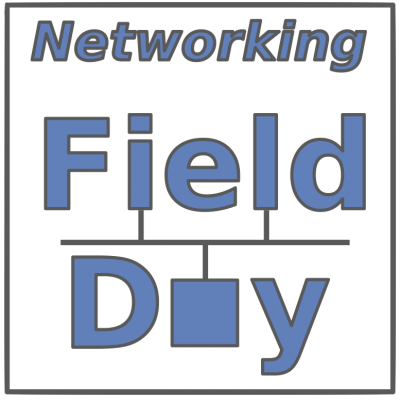I’m looking forward to Networking Field Day 16 in Silicon Valley, henceforth referred to as #NFD16.
On the techie delegate side, we’ve got some of the usual suspects (thought leaders, bloggers, social media presences): me, Terry Slattery, Amy Arnold, Carl Niger, Chris Marget, David Kuchenski, Ethan Banks, Gian Paolo Boarina, Ivan Pepelnjak, Jason Edelman, Jeff Tantsura, Richard McIntosh (as of Sept. 5, 2017 writing).
We’ll be doing our best to provide lively interaction and reactions to the presenters and demos, asking questions we (and hopefully you) would like answered. The sessions will be video streamed live, and if you’re watching live, you can tweet or email me or any of the other attendees any questions you’d like us to ask. Twitter handles can be found on the Tech Field Day #NFD16 web page. For those interested in the live streams (and live tweeting, inevitably with a storm of snark and putrid

puns), the current schedule of vendor presentations is posted and updated on that web page, as well.
The vendors presenting (as of the time this was written): Apstra, Veriflow, Arista Networks, KEMP Technologies, Pluribus Networks, Gigamon, and Kentik. Oh, and a little non-startup named Cisco.
The schedule of presentation times is now posted on the #NFD16 site.
I can’t tell you what Cisco will be presenting on, because I don’t know. Possibly intent-based networking? But hey, the details of what will be presented for all the companies are often kept quiet (new announcements, etc.).
Apstra did a great job presenting on intent-based networking at #NFD13. My prior blog about it: NFD13: Apstra’s Unique Approach to Networking. Apstra is generating a lot of market attention. Plus, I’m convinced that most organizations looking to do software-defined networking (SDN) need to buy a “canned” user-friendly supported solution, not put together rough snippets of unmaintainable code. We don’t all have the time to be coders! Yes, we may leverage APIs to drive products that do most of the heavy lifting. Be that as it may, I see solutions like Apstra as supporting deploying and managing a network module such as a datacenter or campus fabric, in and of itself. I’m looking forward to hearing what’s new with Apstra!
I’ve had a demo and spoken with Veriflow before (see my blog, Network Verification with Veriflow). Interesting product, competitor to Forward Networks (see also the blog NFD13: Forward Networks Comes Out of Stealth to Impress). If you like the idea of pre-validating and doing network assurance, be sure to watch the session! The offline troubleshooting aspect of such tools also gets my attention.
Per their website, KEMP has SLB/ADC with monitoring, in appliance, virtual, and cloud forms — as well as WAF and edge security products.
Pluribus Networks provides a “virtualized network operating system” (NOS) for white box switches, also (separately) packet/flow analytics via SPAN port.
Gigamon was kind enough to reach out to me and then visit NetCraftsmen in our offices. They’ve certainly got a large customer base, and are clearly focused on getting the SPAN/packet data from where it originates to where you need it, e.g. security tools. Concerning packet analysis, I personally find WireShark painful and slow for most troubleshooting — great tool, it’s just TMI (Too Much Information) sometimes. But when you need to quickly feed WireShark packets from somewhere in your datacenter or local network, Gigamon or similar products are productivity-enhancing.
Admittedly, there are exercise benefits from visiting closets — but configuring SPAN ports hastily is one way to shoot yourself in the foot (been there, done that once, lesson learned). What I think I do want is smart tools that can look at packet flows and tell me about anomalies. About a year ago, I saw demos by Riverbed with some such capabilities. For that, Gigamon is an enabler.
Concerning Kentik, I know that it impressed delegates at some prior Tech Field Day events. I’ll be very interested in their story. Baselining and analytics gets my attention (that seems like the next Thing as far as automated detection of network problems). I see that Kentik can ingest packet feeds from NPBs (Network Packet Brokers) like Gigamon. Sounds like my above wish might come true!
My story here is perhaps a bit mixed: We certainly need application flow data (and aggregation/correlation to applications) to understand applications, especially if rework or relocation to the cloud is planned. Having said that, I find myself mixed on NetFlow-type data: good for who ate my WAN or internet link, good perhaps for security (who’s talking, top talkers, etc.), but aside from bandwidth saturation, how does it help me with “network brownouts,” link problems (errors), overloaded network devices (discards), and the like? Anomalies in application traffic levels might be one indicator.
To sum up, #NFD16 has a bit of a coherent story going for it. Start with Arista, which gets your packets from A to B. Alternatively, Pluribus + supported white box switches. Or Cisco. Apstra helps you build and deploy the network. KEMP can load balance applications and monitor that, both in your datacenter and the cloud, while adding visibility. Veriflow tells you via modeling where the packets will go or get blocked, either before or after you build it. Gigamon will help you get copies of your packets to analyzer tools, and can generate NetFlow for you, too. Kentik can work with packets and flow info to tell you what’s going on. Ditto for Pluribus Analytics.
I certainly expect to flesh out the above website gleanings at #NFD16. I hope you’ll be able to watch the live video streams, but if work hours preclude doing so, be sure to entertain yourself in the evenings by watching them later!
Comments
Comments are welcome, both in agreement or constructive disagreement about the above. I enjoy hearing from readers and carrying on deeper discussion via comments. Thanks in advance!


